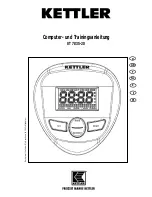
Appendix
Additional 44 kHz Effect Descriptions
XIII
ER TIME (L & R)
Ranges: 0 to 127
This controls the amount of time it takes for the early reflections to be injected into the reverb.
Early reflections are the sounds that have been reflected back from the walls or other reflective
surfaces.
ER LEVEL (L & R)
Ranges: -99 to +99
Controls the level of early reflections of the input signal added directly to the reverb output.
Experiment with both positive and negative on all echoes to change the tonal character of the
results.
FM MIN and MAX
Range:
0 to 127 (corresponding to the SPEED setting)
Allows you to set the FM modulation amount for the minimum speed (SPEED=MIN) and for the
maximum speed (SPEED=MAX). FM modulation is the detuning amount applied to the rotating
speaker. This can be used to create a “Doppler” effect.
GAIN
Range:
-99 to +48 dB
Sets the amount of boost or cut applied to the mid-frequency parametric.
GAIN (BASS FC)
Range:
-48 to +24 dB
Sets the amount of boost or cut applied to the low-frequency parametric.
GAIN (MID FC)
Range:
-48 to +24 dB
Sets the amount of boost or cut applied to the mid-frequency parametric.
GAIN (TREBLE FC)
Range:
-48 to +24 dB
Sets the amount of boost or cut applied to the high-frequency parametric.
GAIN BASS
Range:
-99 to +48 dB
Sets the bass amount of boost or cut applied to a 0 to 80Hz low-shelving filter.
HF DAMPING
Range:
0 to 99
Controls the rate of attenuation of high frequencies in the decay of the reverberation. As natural
reverb decays, some high frequencies tend to get absorbed by the environment. Increasing the
value of this parameter will filter out increasing amounts of high-frequency energy.
INERTIA
Range:
0 to 127
Determines how long it will take for the rotor effect to speed up and slow down after switching
from MAX to MIN or vice versa. Adjust this parameter to simulate the effect of the rotary
speaker gradually picking up speed.
INPUT TRIM
Range:
-24 to +0 dB
Allows you to adjust the input level trim to the EQs to eliminate the possibility of clipping
boosted signals.
LFO SPREAD
Range:
0 to 127
Controls the speed of the three left and three right oscillators relative to one another. A setting of
0 offers the same speed between the oscillators, whereas a setting of 127 would yield an octave
between 1 and 2, and 2 and 3.
MAX
Range:
0 to 130
Determines the rate of the rotary speaker when in the “MAX” setting. The higher the value, the
faster the rate.












































